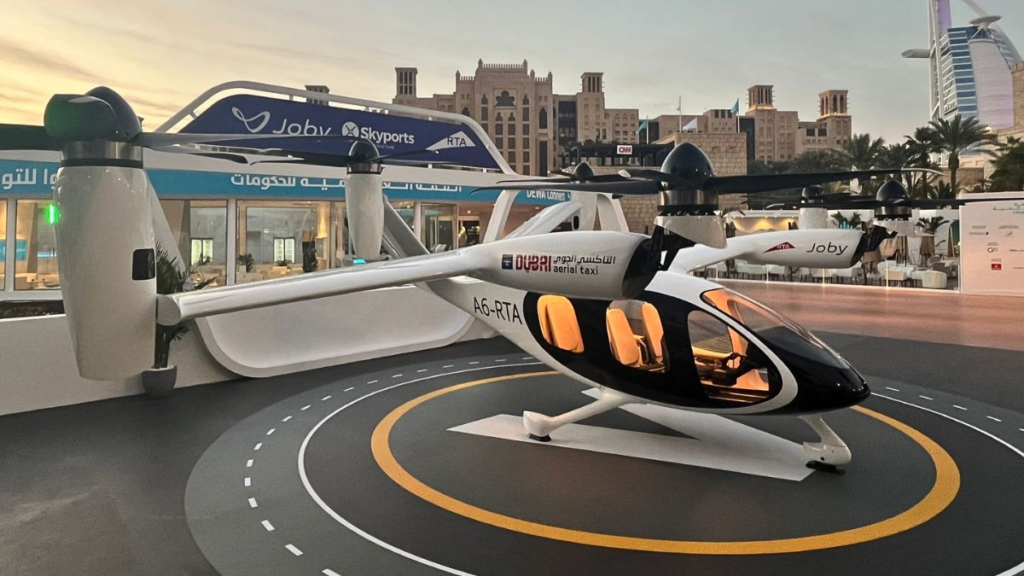Dubai has never been shy about imagining the future before the rest of the world. From driverless Metro trains to AI-powered public services, the city has consistently turned ambitious ideas into everyday reality. Now, another step in that direction is unfolding: electric air taxis that may one day cost no more than a typical Uber or Careem ride.
That is the vision shared by Ahmed Bahrozyan, CEO of the Public Transport Agency at the Roads and Transport Authority (RTA), speaking at the Dubai Airshow 2025. As the city prepares for commercial electric air taxi operations through Joby Aviation, the goal is clear—make aerial travel a normal, affordable part of public transport.
A New Way to Travel Across Dubai

Dubai’s transport landscape has changed dramatically over the last two decades. Residents remember the excitement surrounding the launch of the Metro in 2009. Since then, transport options have grown to include AI-driven taxis, integrated Nol systems, water mobility, and now, futuristic eVTOL aircraft.
The first real public demonstration came at the Dubai Airshow 2025, where Joby Aviation flew its electric vertical take-off and landing (eVTOL) air taxi in full view of visitors. Quiet, sleek, and designed for short urban hops, the aircraft presents a different kind of travel—one that lifts commuters above the traffic of Sheikh Zayed Road and drops them closer to their destination.
During the show, Bahrozyan confirmed that while initial pricing is still under discussion, the long-term ambition is accessibility.
“People ask a lot about how much it will cost. We have not decided the price yet, but it will be cheaper than helicopters today in Dubai. The aim and the vision are for it to eventually, after a few years, be equivalent to almost an Uber or Careem trip in the city,” he said.
But the Prices Will Eventually Come Down
Anyone living in Dubai knows that new technologies often start premium and then—once widely adopted—become surprisingly practical. The same happened with digital tolls, smart gates, Nol usage, and public charging for electric vehicles.
Bahrozyan explained that electric air taxis will follow a similar curve.
“Building these aircraft is going to be expensive initially; operating them is also expensive. Eventually, with economies of scale, prices will come down, operational costs will decrease, and the technology will improve. Therefore, it will become more affordable for people.”
In simple terms, the more air taxis Dubai deploys, the cheaper they will be to run. Maintenance will improve. Manufacturing will become more efficient. Charging and battery systems will evolve. And just like that, a ride that once felt premium could cost the same as booking a car to Mall of the Emirates or Dubai Marina.
Not a Luxury Ride – Part of Daily Public Transport
One of the most important elements of the project is positioning. Dubai does not want air taxis to become a novelty used only by tourists or VIP passengers. The vision is much bigger—and more grounded.
The service is meant to sit alongside:
- Metro
- Buses
- Taxis
- Tram
- Marine transport
Air taxis will not replace any of these options, but rather provide a faster alternative for long or congested routes. Imagine someone needing to commute from Palm Jumeirah to Business Bay during peak office hours. Instead of sitting behind a long line of brake lights, they might take a short aerial hop and arrive within minutes.
This model also reflects the city’s geographic layout. Dubai is not a compact city built around a single downtown. It stretches across multiple commercial and residential zones—from Jebel Ali to Mirdif. Air routes could help tie these areas together without relying solely on roads.
Real Flights Already Happening
This concept is not stuck in planning meetings or presentations. Joby Aviation has already completed trial flights in the UAE, including a point-to-point route that marks a regional first. The milestone signals that the technical side of the operation is moving rapidly.
The public demonstration at Dubai Airshow only reinforced how close this reality is. Visitors watched the aircraft take off, maneuver, and land smoothly—silent enough to imagine passing overhead without disturbing residential or commercial areas.
Dubai has also been preparing the regulatory framework, flight corridors, and vertiport planning to ensure that once the service launches, it fits within the existing public mobility ecosystem.
How Residents May Use Air Taxis in the Near Future
Dubai’s residents have become used to embracing new transport systems quickly. Nol cards are second nature. Digital parking payments happen without a second thought. Even AI surveillance and smart crossings have become part of daily life.
Once air taxis are launched commercially, everyday use could look like this:
- Open the same app used for Metro or bus journeys
- Choose an air taxi route between approved vertiports
- Pay through Nol or unified transport accounts
- Travel above city traffic in a few minutes
And the most encouraging point—RTA wants this to be financially approachable. That alone could change commuting patterns across Dubai.
Dubai’s Future Is Looking Up—Literally
Cities around the world are studying eVTOL transport, but few have the infrastructure and urban vision to deploy it quickly. Dubai does. It already has airspace flexibility, growing mobility networks, and a leadership mindset built around rapid implementation.
If the RTA delivers the affordability it aims for, Dubai may become the first city where boarding an air taxi is as normal as hailing a car from the curb.
And that sounds like something that fits perfectly into the city’s long-running story: the future landing here before it arrives anywhere else.
Read More:
- Dubai Ports Authority Introduces AI-Powered System to Speed Up Approvals and Permits – Social Kandura
- Diriyah Storytelling Festival 2025 brings two weeks of joy – Social Kandura
Follow Social Kandura for more updates on local news and things to do in Dubai and across the UAE.











